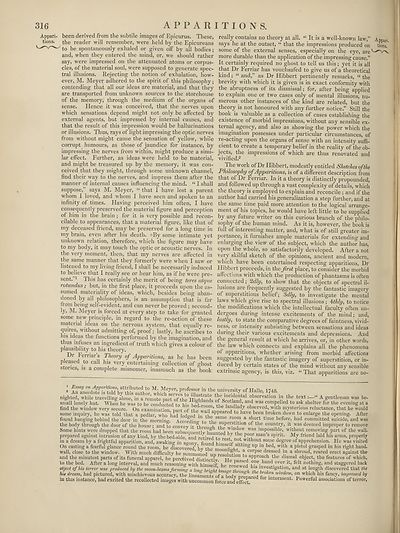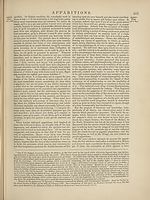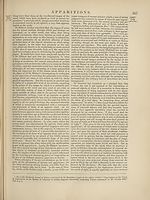Encyclopaedia Britannica > Volume 3, Anatomy-Astronomy
(324) Page 316
Download files
Complete book:
Individual page:
Thumbnail gallery: Grid view | List view

APPARITIONS.
316
Appari- been derived from the subtile images of Epicurus. These,
tions. the reader will remember, were held by the Epicureans
to be spontaneously exhaled or given off by all bodies;
and, when they entered the mind, or, we should rather
say, were impressed on the attenuated atoms or corpus¬
cles, of the material soul, were supposed to generate spec¬
tral illusions. Rejecting the notion of exhalation, how¬
ever, M. Meyer adhered to the spirit of this philosophy;
contending that all our ideas are material, and that they
are transported from unknown sources to the storehouse
of the memory, through the medium of the organs of
sense. Hence it was conceived, that the nerves upon
which sensations depend might not only be affected by
external agents, but impressed by internal causes, and
that the result of this impression would be hallucinations
or illusions. Thus, rays of light impressing the optic nerves
from without might cause the sensation of yellow, while
corrupt humours, as those of jaundice for instance, by
impressing the nerves from within, might produce a simi¬
lar effect. Further, as ideas were held to be material,
and might be treasured up by the memory, it was con¬
ceived that they might, through some unknown channel,
find their way to the nerves, and impress them after the
manner of internal causes influencing the mind. “ I shall
suppose,” says M. Meyer, “ that I have lost a parent
whom I loved, and whom I have seen and spoken to an
infinity of times. Having perceived him often, I have
consequently preserved the material figure and perception
of him in the brain ; for it is very possible and recon¬
cilable to appearances, that a material figure, like that of
m3' deceased friend, may be preserved for a long time in
my brain, even after his death. By some intimate yet
unknown relation, therefore, which the figure may have
to my body, it may touch the optic or acoustic nerves. In
the very moment, then, that my nerves are affected in
the same manner that they formerly were when I saw or
listened to my living friend, I shall be necessarity induced
to believe that I really see or hear him, as if he were pre¬
sent.11 This has certainly the merit of being teres atque
rotundus; but, in the first place, it proceeds upon the as¬
sumed materiality of ideas, which, besides being aban¬
doned by all philosophers, is an assumption that is far
from being self-evident, and can never be proved ; second¬
ly, M. Meyer is forced at every step to take for granted
some new principle, in regard to the re-action of these
material ideas on the nervous system, that equally re¬
quires, without admitting of, proof; lastly, he ascribes to
ns ideas the functions performed by the imagination, and
thus infuses an ingredient of truth which gives a colour of
plausibility to his theory.
Dr Ferriar s Theory of Apparitions, as he has been
pleased to call his very entertaining collection of ghost
stories, is a complete misnomer, inasmuch as the book
really contains no theory at all. “ It is a well-known law,” Appari.
says he at the outset, “ that the impressions produced on tions.
some of the external senses, especially on the eye, are ^"v-v
more durable than the application of the impressing cause.”
It certainly required no ghost to tell us this; yet it is all
that Dr Ferriar has vouchsafed to give us of a theoretical
kind; “ and,” as Dr Hibbert pertinently remarks, “ the
brevity with which it is given is in exact conformity with
the abruptness of its dismissal; for, after being applied
to explain one or two cases only of mental illusions, nu¬
merous other instances of the kind are related, but the
theory is not honoured with any further notice.” Still the
book is valuable as a collection of cases establishing the
existence of morbid impressions, without any sensible ex¬
ternal agency, and also as showing the power which the
imagination possesses under particular circumstances, of
re-acting upon the organs of sense with an intensity suffi¬
cient to create a temporary belief in the reality of the ob¬
jects, the impressions of which are thus renovated and
vivified.2
The work of Dr Hibbert, modestly entitled Sketches of the
Philosophy of Apparitions, is of a different description from
that of Dr Ferriar. In it a theory is distinctly propounded,
and followed up through a vast complexity of details, which
the theory is employed to explain and reconcile ; and if the
author had carried his generalization a step further, and at
the same time paid more attention to the logical arrange¬
ment of his topics, he would have left little to be supplied
by any future writer on this curious branch of the philo-
s°phy of the human mind. As it is, however, the book is
full of interesting matter, and, what is of still greater im¬
portance, it furnishes ample materials for extending and
enlarging the view of the subject, which the author has,
upon the whole, so satisfactorily developed. After a not
very skilful sketch of the opinions, ancient and modern,
which have been entertained respecting apparitions, Dr
Plibbert proceeds, in the first place, to consider the morbid
affections with which the production of phantasms is often
connected; ''Zdly, to show that the objects of spectral il¬
lusions are frequently suggested by the fantastic imagery
of superstitious belief; Sdly, to investigate the mental
laws which give rise to spectral illusions; kthly, to notice
the modifications which the intellectual faculty often un¬
dergoes during intense excitements of the mind; and,
lastly, to state the comparative degrees of faintness, vivid¬
ness, or intensity subsisting between sensations and ideas
during their various excitements and depressions. And
the general result at which he arrives, or, in other words,
the law which connects and explains all the phenomena
of apparitions, whether arising from morbid affections
suggested by the fantastic imagery of superstition, or in¬
duced by certain states of the mind without any sensible
extrinsic agency, is this, viz. “ That apparitions are no-
■ Essay on Apparitions, attributed to M. Meyer, professor in the university of Halle 1748
‘fT'fT1 text:—“ A gentleman was b,
small lonely hut. When he was to be conducted to his hJi r S °fi ^ot an^ was compelled to ask shelter for the evening at
find the window very secure. On examination nart of tho wnU1”’ W acJ-^ observed, with mysterious reluctance, that he woul
some inquiry, he was told that a pedlar, who had lodged in t0 iave been broken down to enlarge the opening. Afte
found hanging behind the door in the morning. Accordino- to tho 8 r°^ a time before, had committed suicide, and w£
the body through the door of the house; and to convey it thrnmrh ,uPer.stltlon of t1?6 country, it was deemed improper to remov
Some hints were dropped that the room had been subsequently hfnnLd vWaS imPosslble, without removing part of the wal
prepared against intrusion of any kind, by the bed side and roV it ^ ^ ^ man s sPint- My friend laid his arms, properl
in a dream by a frightful apparition, and, awaking in aZv foond 1° ^ Wlth°Ut SOme deSree of apprehension. He was visite
On casting a fearful glance round the room, he discovered7by the moonlight UP m}ed’ "’lth a Pistol grasped in his right hanc
wall, close to the window. With much difficulty he summniWI 1 ? torPse dressed in a shroud, reared erect against th
and the minutest parts of its funeral apparel, he perceived distinctly ^He ,the di?mal object, the features of whicli
to the bed. After a long interval, and much reasoning with himself he renewed hlfi han<.1.ovfe.r f(dt nothing, and staggered bac.
object of his terror was produced by the moon-beams forming a long bright image through ^ Vf tlgatl°!b and at ength discovered that th
his dream, had pictured, with mischievous accuracy, the lin^menS of a bodv urfirS \:ok?n™do^ ™ which his fancy, impressed b
in this instance, had excited the recollected images with uncommon force and^E lnte™ent. Powerful associations of terror
316
Appari- been derived from the subtile images of Epicurus. These,
tions. the reader will remember, were held by the Epicureans
to be spontaneously exhaled or given off by all bodies;
and, when they entered the mind, or, we should rather
say, were impressed on the attenuated atoms or corpus¬
cles, of the material soul, were supposed to generate spec¬
tral illusions. Rejecting the notion of exhalation, how¬
ever, M. Meyer adhered to the spirit of this philosophy;
contending that all our ideas are material, and that they
are transported from unknown sources to the storehouse
of the memory, through the medium of the organs of
sense. Hence it was conceived, that the nerves upon
which sensations depend might not only be affected by
external agents, but impressed by internal causes, and
that the result of this impression would be hallucinations
or illusions. Thus, rays of light impressing the optic nerves
from without might cause the sensation of yellow, while
corrupt humours, as those of jaundice for instance, by
impressing the nerves from within, might produce a simi¬
lar effect. Further, as ideas were held to be material,
and might be treasured up by the memory, it was con¬
ceived that they might, through some unknown channel,
find their way to the nerves, and impress them after the
manner of internal causes influencing the mind. “ I shall
suppose,” says M. Meyer, “ that I have lost a parent
whom I loved, and whom I have seen and spoken to an
infinity of times. Having perceived him often, I have
consequently preserved the material figure and perception
of him in the brain ; for it is very possible and recon¬
cilable to appearances, that a material figure, like that of
m3' deceased friend, may be preserved for a long time in
my brain, even after his death. By some intimate yet
unknown relation, therefore, which the figure may have
to my body, it may touch the optic or acoustic nerves. In
the very moment, then, that my nerves are affected in
the same manner that they formerly were when I saw or
listened to my living friend, I shall be necessarity induced
to believe that I really see or hear him, as if he were pre¬
sent.11 This has certainly the merit of being teres atque
rotundus; but, in the first place, it proceeds upon the as¬
sumed materiality of ideas, which, besides being aban¬
doned by all philosophers, is an assumption that is far
from being self-evident, and can never be proved ; second¬
ly, M. Meyer is forced at every step to take for granted
some new principle, in regard to the re-action of these
material ideas on the nervous system, that equally re¬
quires, without admitting of, proof; lastly, he ascribes to
ns ideas the functions performed by the imagination, and
thus infuses an ingredient of truth which gives a colour of
plausibility to his theory.
Dr Ferriar s Theory of Apparitions, as he has been
pleased to call his very entertaining collection of ghost
stories, is a complete misnomer, inasmuch as the book
really contains no theory at all. “ It is a well-known law,” Appari.
says he at the outset, “ that the impressions produced on tions.
some of the external senses, especially on the eye, are ^"v-v
more durable than the application of the impressing cause.”
It certainly required no ghost to tell us this; yet it is all
that Dr Ferriar has vouchsafed to give us of a theoretical
kind; “ and,” as Dr Hibbert pertinently remarks, “ the
brevity with which it is given is in exact conformity with
the abruptness of its dismissal; for, after being applied
to explain one or two cases only of mental illusions, nu¬
merous other instances of the kind are related, but the
theory is not honoured with any further notice.” Still the
book is valuable as a collection of cases establishing the
existence of morbid impressions, without any sensible ex¬
ternal agency, and also as showing the power which the
imagination possesses under particular circumstances, of
re-acting upon the organs of sense with an intensity suffi¬
cient to create a temporary belief in the reality of the ob¬
jects, the impressions of which are thus renovated and
vivified.2
The work of Dr Hibbert, modestly entitled Sketches of the
Philosophy of Apparitions, is of a different description from
that of Dr Ferriar. In it a theory is distinctly propounded,
and followed up through a vast complexity of details, which
the theory is employed to explain and reconcile ; and if the
author had carried his generalization a step further, and at
the same time paid more attention to the logical arrange¬
ment of his topics, he would have left little to be supplied
by any future writer on this curious branch of the philo-
s°phy of the human mind. As it is, however, the book is
full of interesting matter, and, what is of still greater im¬
portance, it furnishes ample materials for extending and
enlarging the view of the subject, which the author has,
upon the whole, so satisfactorily developed. After a not
very skilful sketch of the opinions, ancient and modern,
which have been entertained respecting apparitions, Dr
Plibbert proceeds, in the first place, to consider the morbid
affections with which the production of phantasms is often
connected; ''Zdly, to show that the objects of spectral il¬
lusions are frequently suggested by the fantastic imagery
of superstitious belief; Sdly, to investigate the mental
laws which give rise to spectral illusions; kthly, to notice
the modifications which the intellectual faculty often un¬
dergoes during intense excitements of the mind; and,
lastly, to state the comparative degrees of faintness, vivid¬
ness, or intensity subsisting between sensations and ideas
during their various excitements and depressions. And
the general result at which he arrives, or, in other words,
the law which connects and explains all the phenomena
of apparitions, whether arising from morbid affections
suggested by the fantastic imagery of superstition, or in¬
duced by certain states of the mind without any sensible
extrinsic agency, is this, viz. “ That apparitions are no-
■ Essay on Apparitions, attributed to M. Meyer, professor in the university of Halle 1748
‘fT'fT1 text:—“ A gentleman was b,
small lonely hut. When he was to be conducted to his hJi r S °fi ^ot an^ was compelled to ask shelter for the evening at
find the window very secure. On examination nart of tho wnU1”’ W acJ-^ observed, with mysterious reluctance, that he woul
some inquiry, he was told that a pedlar, who had lodged in t0 iave been broken down to enlarge the opening. Afte
found hanging behind the door in the morning. Accordino- to tho 8 r°^ a time before, had committed suicide, and w£
the body through the door of the house; and to convey it thrnmrh ,uPer.stltlon of t1?6 country, it was deemed improper to remov
Some hints were dropped that the room had been subsequently hfnnLd vWaS imPosslble, without removing part of the wal
prepared against intrusion of any kind, by the bed side and roV it ^ ^ ^ man s sPint- My friend laid his arms, properl
in a dream by a frightful apparition, and, awaking in aZv foond 1° ^ Wlth°Ut SOme deSree of apprehension. He was visite
On casting a fearful glance round the room, he discovered7by the moonlight UP m}ed’ "’lth a Pistol grasped in his right hanc
wall, close to the window. With much difficulty he summniWI 1 ? torPse dressed in a shroud, reared erect against th
and the minutest parts of its funeral apparel, he perceived distinctly ^He ,the di?mal object, the features of whicli
to the bed. After a long interval, and much reasoning with himself he renewed hlfi han<.1.ovfe.r f(dt nothing, and staggered bac.
object of his terror was produced by the moon-beams forming a long bright image through ^ Vf tlgatl°!b and at ength discovered that th
his dream, had pictured, with mischievous accuracy, the lin^menS of a bodv urfirS \:ok?n™do^ ™ which his fancy, impressed b
in this instance, had excited the recollected images with uncommon force and^E lnte™ent. Powerful associations of terror
Set display mode to:
![]() Universal Viewer |
Universal Viewer | ![]() Mirador |
Large image | Transcription
Mirador |
Large image | Transcription
Images and transcriptions on this page, including medium image downloads, may be used under the Creative Commons Attribution 4.0 International Licence unless otherwise stated. ![]()
| Encyclopaedia Britannica > Encyclopaedia Britannica > Volume 3, Anatomy-Astronomy > (324) Page 316 |
|---|
| Permanent URL | https://digital.nls.uk/193761560 |
|---|
| Attribution and copyright: |
|
|---|---|
| Shelfmark | EB.16 |
|---|---|
| Description | Ten editions of 'Encyclopaedia Britannica', issued from 1768-1903, in 231 volumes. Originally issued in 100 weekly parts (3 volumes) between 1768 and 1771 by publishers: Colin Macfarquhar and Andrew Bell (Edinburgh); editor: William Smellie: engraver: Andrew Bell. Expanded editions in the 19th century featured more volumes and contributions from leading experts in their fields. Managed and published in Edinburgh up to the 9th edition (25 volumes, from 1875-1889); the 10th edition (1902-1903) re-issued the 9th edition, with 11 supplementary volumes. |
|---|---|
| Additional NLS resources: |
|

